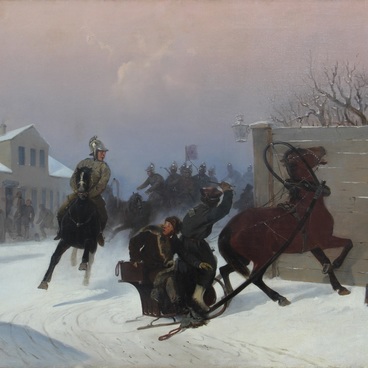The painting A View of the Embankment at the Academy of Arts from the museum collection is a rare painted piece by Stepan Galaktionov, a Russian master of engraving. He captured a part of the embankment in St. Petersburg that is called University Embankment today.
During the construction of St. Petersburg, architectural views of the new capital city were usually engraved. In the early 19th century, painted cityscapes began to come into vogue. Since the first days of its existence, the Neva River quay adorned with ancient Egyptian sphinxes made from pink granite became an important part of the architectural complex and turned in a symbol of the Academy of Arts.
It was architect Konstantin Thon who designed the pier. He planned to decorate the waterfront of the embankment with horse sculpture. When the project design was nearing completion, news came that two sculpted sphinxes had been discovered during excavation work at the site of Thebes, an ancient Egyptian city. Russia purchased the sculptures. In 1832, they were brought to St. Petersburg, and in 1834, took their places on the waterfront. The sphinxes infused the architectural panorama with a romantic tone, and the composition complemented with stylized antique bronze lights and gryphon figures on the steps evolved into a scene so much preferred by artists.
In the canvas A View of the Embankment at the Academy of Arts, Galaktionov depicted a granite quay with columns and a statue of a sphinx in the middle, with the river surface to the right. The artist painted a moon-glade on the water, and that narrative and compositional technique made the painting very striking and eye-catching. Walkers can be seen on the embankment and on the observation site. To the left of the observation site, a boat is touching land, and two sailboats are visible at a distance. The picture belongs to a special type of the image of nature — it is a so-called mood landscape where emotions are emphasized by the effect of nocturnal lighting.
Stepan Galaktionov was a Russian graphic artist, lithographer and landscape painter, an academician and professor emeritus at the Imperial Academy of Arts. He taught at the Academy between 1817 and 1854, made copper prints, lithographs, created vignettes for St. Petersburg almanacs and magazines, produced illustrations for books by Alexander Pushkin, Ivan Krylov and other Russian authors.



